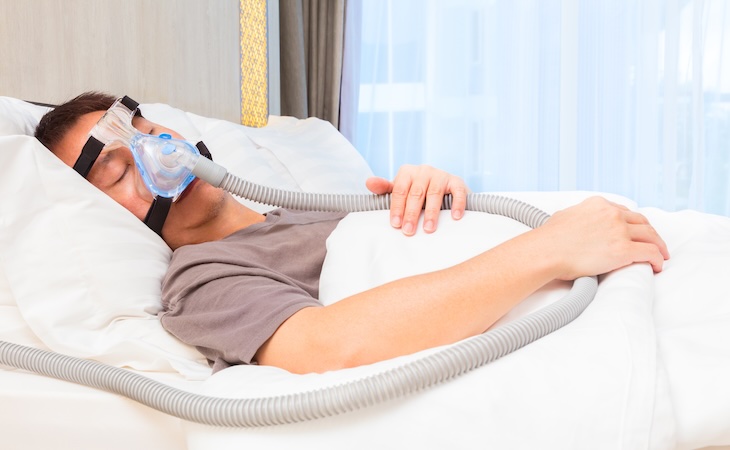Have you or someone you love been diagnosed with sleep apnea? You’re not alone. Doctors estimate that about six million Americans live with this common sleep disorder.
Fortunately, CPAP machines are a safe, effective treatment for sleep apnea. This article will share everything someone with sleep apnea needs to know about using a CPAP.
What is a CPAP machine?
A CPAP (continuous positive airway pressure) machine is the most effective treatment for sleep apnea, according to Stephanie Stahl, MD, a sleep disorders specialist at IU Health Physicians Sleep Medicine.
“[It] is a fancy compressor that uses pressurized air through a type of mask to blow in air through your nose,” she explains. The force of the air prevents the tongue and surrounding tissues from collapsing and narrowing the airway.
How to use a CPAP machine
Though it might feel strange at first, using a CPAP is quite straightforward.
Set it up in the right place
Place your CPAP on a flat, stable surface near where you sleep. The hose shouldn’t be pulled tight. Many people set up their CPAP machines on their nightstands.
Read the instructions
Some CPAPs use different filters than others. CPAP hoses—the component that attaches the mask to the machine—can also come in different sizes. So always follow the specific setup and use instructions from the company supplying your CPAP machine. If you have questions, Stahl suggests asking your CPAP supplier or doctor.
Maintain the CPAP
For storage, place the CPAP in an upright position with enough space so that the hose doesn’t kink. For hygiene purposes, always wash your face before using the CPAP mask. Manufacturers often recommend daily cleaning. At a minimum, disassemble and rinse the hose and mask in warm, soapy water once weekly.
How to get used to a CPAP
It’s normal for it to take time to get used to your CPAP machine. The key is to stick with it, says Stahl. She offers a few tips for getting used to using a CPAP machine.
Find the right mask for you
Selecting the best mask for your face shape and needs is important. CPAP masks are available in a variety of types and sizes. These include full face masks, nasal masks, and masks with nasal pillows.
According to Stahl, “mouth breathers” are often given a full face mask that covers the nose and mouth. The trouble, she says, is full face masks often require higher pressure and feel more uncomfortable.
If you’re struggling to get used to the face mask recommended by your doctor, know that you have options. Consider asking to try a face mask of a different type or size.
Practice during the daytime
It’s a big adjustment to go from sleeping without a mask to wearing it eight hours a night. Stahl suggests scheduling a few daytime practice sessions to get used to the way your CPAP mask feels.
“Practice during the daytime while you are watching TV so that it becomes no longer an odd thing then to put on at nighttime,” she says.
Adjust the settings, if possible
A healthcare provider can help you learn the options and adjust the settings of your CPAP machine. For instance, some people find that using a CPAP makes their throats and noses feel dry. The good news is that many machines have a humidifier chamber to help.
In other cases, the pressure feels too high, especially during the first few days and weeks of CPAP use. Some machines have pressure settings that can be manually adjusted. Others have auto-adjusting pressure or a “ramp” feature, which starts with a low pressure that increases gradually as you fall asleep.
FAQs
How do you use a CPAP machine step-by-step?
Always follow the instructions that come with the CPAP. These are the standard steps:
- Place the CPAP machine on a stable surface near the bed.
- Set up the filter if it still needs to be put in place.
- Connect the hose, with one end attached to the machine and the other to the mask.
- Plug in the device.
- Place the mask on your clean, bare face and lie down.
- Adjust the mask until snug, comfortable, and free of air leaks.
- Turn on the machine.
- Go to sleep.
How do I know if I’m using my CPAP correctly?
“Most newer models of PAP machines give people a lot of feedback, including how well the mask is fitting, your usage, and how well it is controlling your sleep apnea,” says Stahl. She recommends consulting the CPAP setup company or your doctor if you have questions or concerns.
Do you breathe through your nose or mouth with a CPAP?
You should breathe through your nose with a CPAP, says Stahl. “Nasal breathing is best for us in general, including during the daytime and sleep,” she adds.
How many hours a night should I use my CPAP?
Because sleep apnea can occur anytime you are asleep, you should use your CPAP every time you sleep—including daytime naps. “Many insurance providers require that you use your CPAP machine four hours a night at least 70% of the days, especially in the first few months that you have your new machine,” Stahl adds.
What are the most common sleep disorders—and how do you know if you have one? Check out our guide to sleep disorders to learn more about sleep apnea, insomnia, and more.




